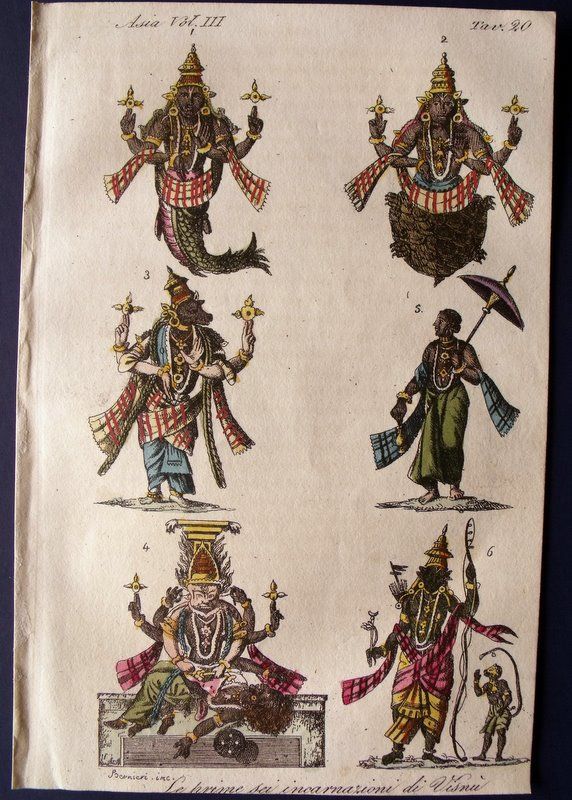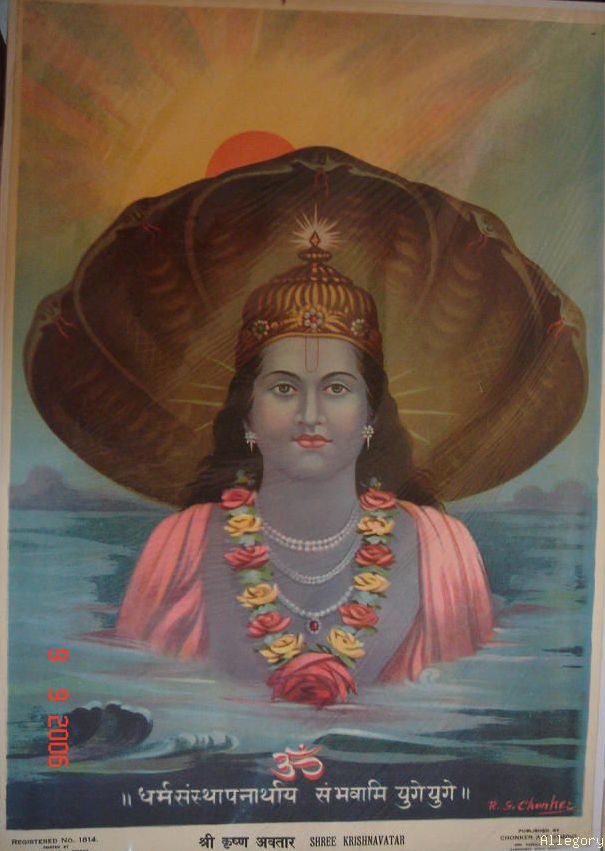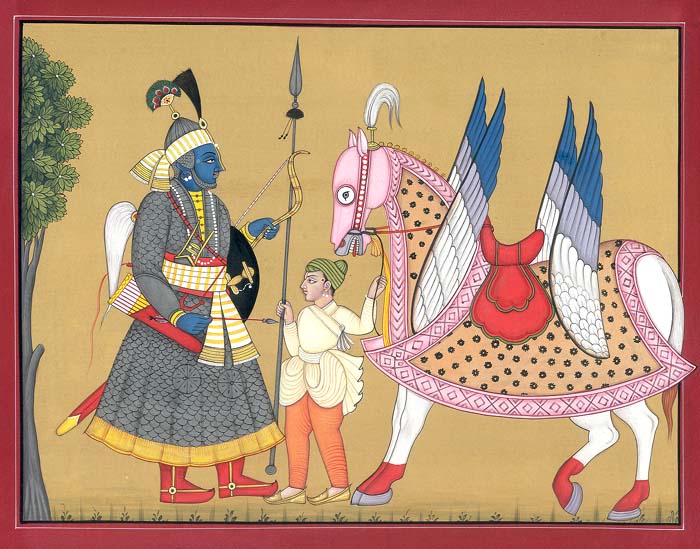


The Sanskrit caption, a quotation from the Bhagavad Gita, affirms Vishnu's pledge to return to earth "in yuga after yuga" for the protection of dharma (bazaar art, c.1950's)
Source: ebay, Dec. 2006
![]()
The ten avatars of Vishnu, a modern Madhubani painting-set
Source: http://www.exoticindiaart.com/paintings/DB35
(downloaded Oct. 2000)
![]()
Another modern set of avatars, by no means identical, from ISKCON
Source: http://www.asitis.com/gallery/plate16.html
(downloaded Nov. 1999)
"The Lord descends whenever there is a decline in religious principles." From an ISKCON (International Society for Krishna Consciousness) website, which provides the following commentary:
"Bhagavad-gita 4.7: In the center square, Krsna is shown in His original two-handed form, holding a flute. Surrounding Him are ten of His eternal incarnations, pictured in the order in which they appear in the material world, beginning clockwise from the lower left-hand corner.1. Matsya, the fish incarnation, is saving the Vedas.
2. Kurma, the tortoise incarnation, is holding the hill on His back.
3. Varaha, the boar incarnation, is fighting with the demon Hiranyaksa.
4. Nrsimhadeva, the lion incarnation, is killing the demon Hiranyakasipu.
5. Vamanadeva, the dwarf incarnation, is begging some land from King Bali.
6. Parasurama is killing the demoniac ksatriyas.
7. Lord Ramacandra is going off into exile with His wife, Sita, and brother, Laksmana.
8. Krsna is lifting Govardhana Hill, and beside Him is His brother Balarama.
9. Lord Buddha.
10. Lord Kalki is riding on His horse, killing all the demons and thus liberating them."
![]()
Vishnu surrounded by his avatars (bazaar art, c.1980's); *another, similar view*
Source: ebay, Sept. 2007
![]()
The ten avatars of Vishnu, in a modern pata-chitra painting from Orissa.
Source: http://www.exoticindiaart.com/paintings/PC54
(downloaded June 2001)
![]()
The ten avatars, in kalamkari work from Andhra Pradesh
Source: http://www.exoticindiaart.com/paintings/PB26
(downloaded June 2001)
![]()
"Twenty-four Incarnations of Vishnu," a modern Madhubani painting by Dhirendra Jha; *another version by the same artists*
Source: http://www.exoticindiaart.com/product/DA99/
(downloaded May 2002)


Kalki, the avatar who will come at the end of the present Kaliyuga
Source: http://www.exoticindia.com/product/HC65/
(downloaded Oct. 2004)
Commentary provided by the seller:
"This queer rendition, largely dominated by folk elements, much in the fashion of a fairy tale, represents contrarily a very serious kind of myth, which various Puranas assert in great unanimity. It depicts Kalki, the tenth incarnation of Vishnu, that is, the last of his Dasavatara yet to take place. Some theologians believe that Kalki has already incarnated, but the version sounds to be wrong. With the incarnation of Kalki the present Kaliyuga would end. The age of the Kaliyuga, as estimated in the Mahabharata and other texts, is 4,32,000 years of which barely 5000 years have so far passed. Thus, this tenth incarnation is yet far off. The concept of the incarnation of Kalki is a pure Vaishnavite assertion of Manu's social order of four varnas and a revival of Brahmanism, something which majority of Indians may not now approve.The Mahabharata Vana Parva, Agni Purana, Padma Purana, Brahma Purana, Brahmavaivarta Purana, Harivansha Purana, Brahmanda Purana, Bhagavata Purana, Vishnudarmottara Purana and several other ancient Brahmanical texts come out with brief but unanimous details of Kalki, comprising the tenth or the eleventh incarnation of Vishnu. Kalki is by and large a prediction, however, quite clear in its vision and in its fictional elaboration.
Acclaimedly, towards the end of Kaliyuga, when righteousness turns into unrighteousness, light into darkness, good into evil, virtues into vices, believers into non-believing profanes, community of man into thieves and evil doers and the faith in God is lost and the Vedas are misinterpreted to serve adharma, Kalki would be born in the house of Vishnuyashas, a Brahmin and the priest of Yajnavalkya, at the village Shambhala. Some texts seem to suggest that Kalki would be born to Vishnuyashas as his son but the others claim that Kalki would be only the other name of Vishnuyashas. This Brahmin, the Dharma manifest, would create arms and soldiers by his will and himself carry a long sword and destroy the wicked malechchh, the low-caste people responsible for adulterating Dharma and breaking social order. He would restore the social order comprising of four varnas, and the four ashramas and all rituals and religions canons. For the fulfillment of his errand gods would give him a horse capable of swift speed in the sky as well as on the earth. Given by devas, or gods, the horse would be known as Devadatta, or the one given by gods.
The artist has largely adhered to this same Puranic elaboration. For delineating him as the last of the Dasavatara the artist has packed in his figure several features of Vishnu's previous incarnations. He has the same body complexion as Vishnu but a different body build, more like a mighty wrestler, such as only Balarama, amongst his incarnations, had. He is wearing a warrior like helmet but with peacock crest of Krishna crowning it. He has on his waist the long sword, as Puranas prescribe with his figure, but in his hands he is holding a bow and arrow, the characteristic attributes of Rama. As compared to his projected role in the fable, he has a shorter stature, something close to Vishnu's Vamanavatara. The armour, which he is putting on, has a fish like look with some sort of resemblance to his Matsyavatara. A well clad and bejeweled deva, with a Vaishnavite tilaka on his forehead and hence of the Vaishnava line, has brought him the horse Devadatta. With both its forelegs folded like an army personnel, the horse seems to salute its new master. The horse obviously has an unearthly bearing and with its wings an unearthly look. Except a partially visible saptaparni tree, the background is plain in opaque golden tint. The wide brownish red border, red feet of horse, features of the two figures, typically folded sash on the waist of the Deva and formal character of the horse have striking resemblance with the medieval miniature art style of Raghogarh in Central India.
This description by Prof. P.C. Jain and Dr Daljeet. Prof. Jain specializes on the aesthetics of ancient Indian literature. Dr Daljeet is the chief curator of the Visual Arts Gallery at the National Museum of India, New Delhi. They have both collaborated on numerous books on Indian art and culture."
== Indian Routes index == Indian Routes sitemap == Glossary == FWP's main page ==